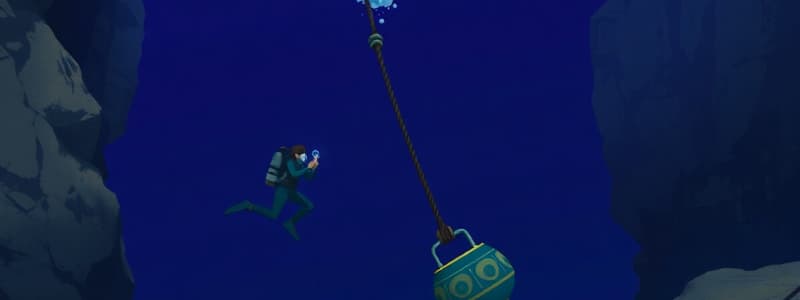Podcast
Questions and Answers
What immediate action did the Diving Supervisor take upon realizing the diver had been lifted off the seabed?
What immediate action did the Diving Supervisor take upon realizing the diver had been lifted off the seabed?
- Instructed the diver to release the umbilical from the clump weight.
- Immediately lowered the port bell clump weight and called an ALL STOP. (correct)
- Ordered the second diver to assist in freeing the snagged umbilical.
- Initiated emergency ascent procedures for the diver.
According to the incident report, which factor contributed to the diver's umbilical snagging on the port bell clump weight?
According to the incident report, which factor contributed to the diver's umbilical snagging on the port bell clump weight?
- The route taken by the diver from the Starboard bell to the worksite. (correct)
- Strong underwater currents pushing the umbilical towards the clump weight.
- The diver's failure to maintain proper buoyancy.
- The diving bell being too close to the seabed.
What additional preventative measure should have been in place to monitor the diver's umbilical, according to the report?
What additional preventative measure should have been in place to monitor the diver's umbilical, according to the report?
- The observation ROV should have focused on the diver's umbilical. (correct)
- A second diver should have been assigned to manage the umbilical.
- A surface team should have monitored the umbilical's position using sonar.
- The umbilical should have been equipped with a quick-release mechanism.
What key element regarding 'Personal Factors' was cited as a potential cause of the incident?
What key element regarding 'Personal Factors' was cited as a potential cause of the incident?
What is the purpose of the the "Time Out For Safety (TOFS)" that was held after the incident?
What is the purpose of the the "Time Out For Safety (TOFS)" that was held after the incident?
Flashcards
Cause of incident
Cause of incident
A diver was lifted off the seabed because their umbilical got caught during a diving bell clump weight adjustment before the bell recovery.
Sequence of Events
Sequence of Events
The diver's umbilical snagged on the port bell clump weight while moving from the bell to the worksite. When the port bell was raised, the diver was lifted off the seabed.
What went wrong?
What went wrong?
The route taken by the diver put the umbilical close to the port bell and its clump weight, and the risk of snagging wasn't recognized.
Safe diving practice
Safe diving practice
Signup and view all the flashcards
Matters to Discuss
Matters to Discuss
Signup and view all the flashcards
Study Notes
- A diver was lifted off the seabed because their umbilical caught on a diving bell clump weight during bell recovery.
What Happened
- While moving from the bell to the worksite, Starboard Diver 2’s umbilical fouled on the port bell clump weight.
- When the port bell was raised to a short mark (about 10m from deployed position) by the Diving Supervisor, Starboard Diver 2 was lifted about 4-5m due to the umbilical being caught.
- The Diving Supervisor called an ALL STOP and the port bell clump weight was lowered until Starboard Diver 2’s umbilical was cleared
- The diver returned to the bell, where his equipment was assessed and he did not lose any services.
- Diver 2 was cleared to return to work using Diver 3’s equipment.
- The bell in use had 3 working divers out, plus the bellman.
What Went Wrong
- The diver’s route from the Starboard bell to the worksite meant the umbilical was close to the port bell and its clump weight.
- The risk of snagging the umbilical on the clump weight was not recognized.
Lessons Learned
- If divers from the starboard bell must pass close to the port bell, the observation ROV should focus on the diver's umbilical.
- Divers who must pass close to objects being lifted or moved from one workplace to another should be monitored by a second diver or an ROV.
- A Time Out For Safety (TOFS) was held in Dive Control with all on shift divers to recognize, discuss, and communicate the near miss, and further discussion was held by Offshore Managers and supervisors.
- Matters to discuss included behaviours (line of fire), tidal effects and current on umbilical slack, the path the diver takes and proximity to objects being lifted, and umbilical drifting.
- Personal factors to discuss included inattention and the possibility of the umbilical snagging and use of the observation ROV to focus on the diver.
Studying That Suits You
Use AI to generate personalized quizzes and flashcards to suit your learning preferences.




